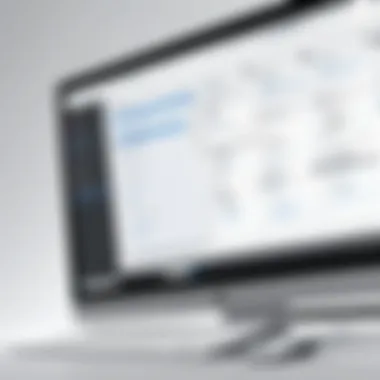Top Note Taking Tools for Windows: A Detailed Evaluation


Intro
In the realm of productivity, the ability to effectively capture, organize, and retrieve information is indispensable. Note-taking tools serve as essential software for individuals and organizations looking to optimize their workflow. For Windows users, the options are vast, offering various features that cater to different needs. This article explores some of the best note-taking applications available for Windows, providing insights into their strengths and weaknesses. Understanding the capabilities of these tools can significantly enhance your organizational skills, leading to improved productivity.
This guide will dissect key aspects such as software features, technical specifications, user experiences, and the general pros and cons of notable applications. Each section aims to furnish you with the knowledge to make an educated choice about which tool aligns with your workflow requirements and preferences.
Software Overview
This section delves into the diverse range of note-taking software available for Windows, examining how they function and the core features they offer.
Software Features
The landscape of note-taking apps is populated by a variety of software, each presenting unique functionalities. Key features often include:
- Text Formatting: Basic options for changing fonts, sizes, and styles
- Multimedia Support: Ability to insert images, audio, and video
- Cloud Synchronization: Automatic saving and access across multiple devices
- Search Functionality: Efficient retrieval of notes based on keywords
- Organizational Tools: Tagging systems and folders for easy categorization
These features are instrumental in aiding users to capture their thoughts more efficiently while ensuring easy access and organization.
Technical Specifications
When evaluating note-taking tools, technical specifications provide crucial insights into their performance. Key aspects may include:
- System Requirements: Minimum hardware and operating system specifications
- Compatibility: Integration with other applications and services
- User Interface (UI): Ease-of-use and aesthetic design considerations
- Security Features: Encryption and privacy features for sensitive data
Understanding technical specifications helps in assessing whether a particular tool meets your operational needs and seamlessly integrates into your current systems.
Peer Insights
User feedback often serves as an invaluable resource in evaluating the efficacy of software. In this section, we will look at actual user experiences and the general sentiments surrounding various note-taking apps.
User Experiences
Real-life testimonials shed light on how these tools perform under typical usage scenarios. Users frequently express their preferences in aspects like:
- Ease of note-taking
- Intuitive navigation
- Customization options
- Overall impact on productivity
Such reviews are essential in gauging how particular software can support or hinder workflow.
Pros and Cons
Every tool has its strengths and weaknesses. Here’s a summary that encapsulates typical pros and cons based on user feedback:
Pros:
- Efficient information capture
- Versatile functionalities
- High adaptability to various workflows
Cons:
- Can be overly complicated for basic needs
- Requires consistent updates
- May face compatibility issues with certain systems
This assessment underlines the importance of matching software capabilities with user needs.
"The right note-taking tool can revolutionize how you manage information and enhance your productivity."
By analyzing these points, readers can gain a clearer understanding of the potential benefits and drawbacks associated with each application, enabling informed decisions in their pursuit of productivity.
Prolusion to Note-Taking Software
Effective note-taking is crucial in today's fast-paced digital environment. It serves as a foundation for capturing ideas, organizing thoughts, and enhancing productivity. The growing need for clarity in information retention and retrieval has led to the development of various note-taking software. This article aims to explore not just these applications, but to understand their significance in both personal and professional contexts.
Importance of Effective Note-Taking
Effective note-taking transcends the mere act of writing down information. It plays a pivotal role in enhancing comprehension and memory. Good notes promote better organization, making it easier to locate information when needed. They provide a structured way to synthesize concepts and facilitate deeper understanding. The act of writing itself can aid in reinforcing memory, establishing a stronger connection to the material. For IT and software professionals, effective note-taking enables them to track project progress, document system requirements, and formulate solutions to complex problems. The efficiency gained through well-maintained notes can lead to significant increases in productivity, fostering both individual and team achievements.
Evolution of Note-Taking Applications
The evolution of note-taking applications reflects technological advancements and changing user needs. Early systems were analog, relying on pen and paper. While they provided free-form creativity, they lacked organization and retrieval features. As computers became commonplace, the first digital note-taking apps emerged. They offered basic functionalities, such as text storage and organization through folders.
With the advent of cloud computing, applications like Evernote and OneNote entered the market, revolutionizing how notes are stored and shared. These platforms provided users with access to their notes from anywhere and encouraged collaboration. Features such as tagging and rich text formatting were introduced to enhance the user experience further.
Now, modern note-taking applications incorporate advanced capabilities, including voice recognition, image insertion, and integration with other software like Microsoft Teams and Slack. This evolution continues, influenced by user feedback and emerging technologies, making note-taking software increasingly versatile and integral to professional workflows. Users are now seeking tools that not only serve as simple text recorders but also support their unique working styles and enhance collaboration.


Criteria for Evaluating Note-Taking Tools
When selecting a note-taking tool, it is important to use specific criteria to ensure that it meets your needs. This section addresses the essential factors that help users identify the most appropriate software for their tasks. Not all tools are created equal, and understanding these criteria can enhance your overall note-taking experience.
User Interface and Experience
The user interface (UI) is the first thing users notice. A clean and intuitive design helps reduce the time needed to learn the software. An effective UI allows users to navigate effortlessly while taking notes. Important elements include the layout, color schemes, and the visibility of options.
A good user experience (UX) contributes equally to the productivity of the user. Tools should enable users to create, organize, and retrieve notes quickly. Features like drag-and-drop capabilities, a responsive layout, and customizable shortcuts can greatly enhance one's efficiency. If the interface is cluttered or complicated, users may struggle to take effective notes. In many cases, simplicity is key.
Integration with Other Software
Note-taking tools often need to work in conjunction with other applications. Integration capabilities can streamline your workflow, allowing for seamless transitions between different tasks and kinds of software. For instance, integration with task management tools or communication platforms like Slack can facilitate a more organized approach to projects.
Furthermore, some applications allow for direct syncing with cloud services, making it easier to access notes across multiple devices. This capability is crucial for users who work from various locations or devices. Overall, the ability to connect with other software can save time and reduce the need to switch between applications constantly.
Customization and Flexibility
Customization options empower users to tailor their note-taking experience to their specific preferences. Various formatting tools like font styles, colors, and layout configurations can make a noticeable difference in usability. Flexibility in organizing notes is also important. Whether through tags, folders, or notebooks, the ability to adapt the note structure according to different workflows increases productivity.
Likewise, advanced features such as the ability to embed images, audio clips, or even links enrich the note-taking process. Custom templates may also serve particular needs, whether for project management or academic studies, making the tool more versatile.
Collaboration Features
In today’s working environment, collaboration is often essential. Effective note-taking tools should support team collaboration, enabling multiple users to access, edit, and comment on notes simultaneously. Features such as shared notebooks or real-time editing capabilities can enhance teamwork and clear communication.
Additionally, users may benefit from tracking changes to see what modifications have been made by collaborators. This transparency helps maintain clarity and accountability, ensuring all team members stay aligned with project objectives.
Search and Organization Tools
The ability to search through notes quickly is a paramount feature. An efficient search function allows users to locate information in a matter of seconds, boosting productivity. Look for tools that offer advanced search techniques, such as searching by tags, keywords, or dates.
In addition, organizational tools enhance the way notes are categorized and arranged. Options like color-coding, hierarchical structures, or automatic sorting can keep information easily accessible. Good organization reduces the chaos that often arises from a growing repository of notes, making it necessary for effective note-taking.
By considering these criteria, users can better assess and choose the note-taking tool best suited for their needs. This not only aids in improving productivity but also ensures that digital note-taking is an efficient and meaningful component of their work routine.
Top Note-Taking Applications for Windows
In the landscape of digital productivity, note-taking applications serve as fundamental tools for individuals and organizations. With the growing need for efficient information management, selecting the right software becomes crucial. These applications can significantly influence the way users capture, organize, and retrieve knowledge. The features, user-friendliness, and integration capabilities of note-taking tools directly impact their effectiveness. This further enhances productivity, making processes smoother for both personal and professional use.
Microsoft OneNote
Features
Microsoft OneNote includes a versatile canvas that allows users to jot down notes in varied formats. It supports ink, text, and images, enabling effective visual organization of thoughts. The integration with Microsoft's ecosystem stands out as a major feature. This connects it seamlessly with other applications like Word and Excel. The OneNote web clipper is another notable feature, allowing easy saving of online content directly into the notes. Such versatility contributes to making OneNote a popular choice among users seeking comprehensive note-taking solutions.
Pros and Cons
OneNote's strengths lie in its rich feature set and compatibility with other Microsoft products. The collaboration capabilities are robust, allowing teams to work together in real time. However, some users find it overwhelming due to its numerous functions. Additionally, syncing issues can arise if one does not have a stable internet connection. Despite these concerns, OneNote remains favored for users embedded in the Microsoft ecosystem.
Best Use Cases
OneNote is particularly effective for students and professionals looking to manage extensive information. Its flexible structure accommodates various note formats, making it ideal for research projects. The app serves well for collaborative tasks due to its sharing features. Users who appreciate visual organization will also find OneNote beneficial, as it enables a connection between text and visual elements efficiently.
Evernote
Features
Evernote showcases a user-friendly interface designed for storing and organizing different types of information. It supports text, images, audio, and web clippings effectively. A unique aspect is Evernote's powerful search functionality, which allows users to find notes rapidly, inclusive of handwritten text. This makes it a robust tool for anyone dealing with large volumes of notes.
Pros and Cons
The advantages of Evernote stem from its simplicity and swift access to stored content. The ability to sync across multiple devices is another appealing aspect. Nevertheless, some users express frustration with the app's pricing structure, particularly as features like offline access are locked behind premium subscriptions. These limitations raise questions for users deciding whether to invest in the premium version.
Best Use Cases
Evernote is well-suited for individuals needing to capture diverse types of information quickly. Researchers and students utilize it to maintain structured notes on multiple subjects. The app also serves business professionals effectively, allowing them to track meeting notes and project ideas in one accessible location.
Notion


Features
Notion presents a novel approach to note-taking with its all-in-one workspace concept. It allows users to create databases, boards, and wikis, offering unmatched customization. This versatility supports various organizational styles, appealing to both individual and team workflows. Notion’s collaborative features also facilitate real-time editing among team members, which enhances project management capabilities.
Pros and Cons
The primary strength of Notion is its adaptability to different user needs. The platform's aesthetic appeal adds to its attractiveness. However, new users may face a significant learning curve due to its complexity. This advanced nature may intimidate users who prefer straightforward note-taking tools.
Best Use Cases
Notion is particularly effective for startups and teams working on collaborative projects. It shines when managing ongoing tasks and storing detailed information. Individuals who appreciate high levels of customization will also benefit greatly from its flexible structure. Notion caters to innovative thinkers looking for an adaptable workspace.
Simplenote
Features
Simplenote champions minimalism, offering a clean interface focused on text-based note-taking. The software's speed and simplicity enable users to focus solely on writing without distractions. It also provides version history, allowing users to retrieve previous versions of their notes easily. Such features are appealing for users who need quick and straightforward options.
Pros and Cons
Simplenote's primary advantage is its lightweight nature, making it suitable for users who prefer basic functionalities. It syncs with various devices, facilitating easy access. However, this simplicity comes at the expense of more advanced features found in competing apps. Users who require extensive organization and multimedia capabilities may find Simplenote limiting.
Best Use Cases
Simplenote is suitable for individuals looking for a straightforward text note-taking solution. Writers and students often use it to draft ideas or maintain simple task lists. Its quick access features make it appealing for users on the go or anyone desiring a no-frills approach.
Google Keep
Features
Google Keep offers an intuitive note-taking experience, with a focus on ease of use. Users can create notes, lists, and reminders while benefiting from Google's ecosystem. The ability to label and color-code notes aids in organization. Its voice recording feature is also valuable for capturing thoughts quickly when writing is not convenient.
Pros and Cons
Google Keep's accessibility across devices stands out, ensuring users can always access their notes. The app is free and easy to navigate, appealing to many users. However, its simplicity may frustrate those looking for more robust functionalities. Users who want extensive features in a note-taking app may find Google Keep insufficient for deeper organizational needs.
Best Use Cases
Google Keep is ideal for quick note-taking and for users who need to integrate notes with Google Calendar or Tasks effectively. Its practical design suits busy professionals and students aiming for fast access to their information. Users looking for a mobile-friendly solution for reminders and short notes will benefit the most from Google Keep.
Comparative Analysis of Note-Taking Apps
An effective comparative analysis of note-taking applications is essential for understanding which software best serves the diverse needs of users. This section delves into the nuances that differentiate each application from one another. By juxtaposing their features, gathering user experiences, and considering cost implications, one can discern the most suitable tools for various contexts. This analysis not only highlights strengths and weaknesses but also aids decision-making for individuals and organizations alike.
Feature Comparison
In the realm of note-taking software, features often determine usability and efficiency. Each application presents unique capabilities that cater to distinct user preferences. For instance, Microsoft OneNote excels in its organizational structure with sections and pages. Evernote stands out for its extensive web clipping abilities and tagging system. Notion offers an all-in-one approach combining note-taking, project management, and collaboration.
Additional features to consider include:
- Search functionalities: A robust search tool helps users retrieve information quickly.
- Cross-platform compatibility: Tools that work on multiple operating systems increase accessibility.
- Template availability: Templates facilitate note-taking and can enhance productivity.
Taking these factors into account provides clarity on how specific features align with user needs, informing their choice in an application.
User Experiences and Feedback
User experiences are key in evaluating the effectiveness of note-taking applications. Feedback can provide insight into real-world usability and functionality. For example, many users of Simplenote appreciate its simplicity and lack of clutter, which appeals to people who value straightforwardness in their note-taking process.
On the other hand, reviews about Notion often highlight its flexibility but also its steep learning curve. Users enjoy customizing their workspaces but sometimes feel overwhelmed by its extensive options. Understanding the sentiments shared in user reviews can guide potential users in gauging how well an application might suit their demands.
Key aspects to consider in user experiences include:
- Ease of use: How intuitive is the interface for new users?
- Reliability: Are there common issues like crashes or loss of data?
- Community support: Is there a vibrant community for troubleshooting and advice?
Cost Considerations
Cost is undoubtedly a critical aspect of any software evaluation. The pricing models of note-taking tools can vary significantly. Microsoft OneNote is free, which makes it an attractive choice for budget-conscious users. In contrast, Evernote offers premium features at a subscription fee, which might appeal to those who need advanced functionalities.
When assessing costs, consider:


- Free vs. Paid Plans: What features are locked behind a paywall?
- Trial Periods: Are there free trials available to test the software?
- Value for Money: Based on features, is the cost justified?
Analyzing the cost structure allows users to make informed decisions based on available budgets and feature requirements.
"The choice of a note-taking application can significantly impact productivity and information management; hence, a thorough comparative analysis is indispensable."
Benefits of Using Note-Taking Software
Note-taking software provides several advantages that can significantly improve both personal and professional efficiency. In a world where information is abundant, having the right tools to organize thoughts, ideas, and important data becomes crucial. This section explores how note-taking apps can elevate productivity, enhance information retention, and offer streamlined collaboration options.
Enhanced Productivity
One of the most significant benefits of using note-taking software is the boost in productivity it offers. Traditional methods of jotting down notes can often slow down the thought process. However, with specialized software, users can capture ideas quickly and efficiently. Features like text formatting, bullet lists, and task management help users stay organized and make revisiting notes easier. Having everything in one place minimizes the time spent searching for information.
- Note-taking applications often offer synchronization across devices. This means a user can access their notes from a laptop, tablet, or smartphone, making it convenient for those on the go.
- Integration with other software such as project management tools can seamlessly incorporate notes into larger workflows, leading to enhanced categorization and follow-ups.
Improved Information Retention
Effective note-taking is not just about recording information; it is about enhancing memory retention. Digital tools often include features that allow for easier reviewing and revising of notes. Using tags and highlighters can help emphasize key points that are important to remember.
Studies indicate that the act of writing helps solidify information in one’s memory. When combined with the organizational tools available in note-taking software, users can categorize notes by subjects or projects, making retrieval quicker and less stressful. The software often includes search functions that allow users to locate specific notes rapidly, which is a significant improvement over manual methods.
"The right note-taking tool can turn disorganized scribbles into a coherent system for understanding and remembering information."
Streamlined Collaboration
Collaboration is vital in many fields, and note-taking software enhances this aspect considerably. Many applications facilitate real-time collaboration, allowing multiple users to edit and comment on documents simultaneously. This is particularly beneficial for teams working on projects or in educational settings.
Key features that promote streamlined collaboration include:
- Shared workspaces where team members can contribute thoughts and ideas collectively.
- Commenting features that enable feedback directly on notes, improving communication fluidity.
- Version history, allowing teams to track changes and revert back if necessary.
Note-taking software, therefore, not only enhances individual productivity and information retention but also fosters a collaborative environment that can lead to more coherent and comprehensive work output.
Challenges of Note-Taking Software
As note-taking software becomes more integral to both individual and organizational workflows, it is essential to address the challenges these tools present. While they offer significant advantages in productivity and information management, the pitfalls associated with their use warrant careful consideration. Understanding these difficulties will help users navigate potential obstacles and make informed decisions when selecting an application.
Over-Reliance on Technology
One of the foremost challenges associated with note-taking software is the potential for over-reliance on technology. When users begin to depend heavily on these tools, they may start to lose essential skills related to traditional note-taking methods. This shift could lead to diminished cognitive engagement and retention of information. Users may find themselves compromising their understanding of subjects simply because they rely too much on stored notes rather than internalizing them.
Moreover, excessive dependence on a specific application can lead to issues if the software faces outages, bugs, or compatibility problems with updates. Users may find it difficult to access critical notes during these interruptions, leading to frustration and decreased productivity. It's crucial for individuals to develop a balanced approach that integrates both digital and analog methods for note-taking, ensuring that they remain intellectually engaged with their content.
Compatibility Issues
Compatibility poses another significant challenge for users of note-taking software. Many applications exist within distinct ecosystems, limiting interoperability with other software. For example, an application optimized for Windows may not function efficiently on other operating systems such as macOS or Linux. This incompatibility can hinder collaboration across diverse teams, as sharing files may require converting formats or using supplementary tools to facilitate accessibility.
Additionally, while some software may offer cloud-sync features, inconsistencies in performance across devices can lead to unexpected problems. For users managing critical information across multiple platforms, ensuring that notes are consistently available and correctly formatted is imperative. Consequently, it becomes necessary to research how an application interacts with other common productivity tools before committing to a specific solution.
Learning Curve and Complexity
Finally, the learning curve associated with various note-taking applications can be a barrier for some users. While many tools strive for user-friendly interfaces, the depth of features offered in applications like Notion and Evernote can overwhelm new users. It can take significant time to learn how to utilize all functionalities effectively. This complexity might lead to poor adoption rates in organizations, as employees may feel frustrated and unequipped to handle the software that is meant to aid them.
A steeper learning curve can also result in inconsistent usage among team members. When not all individuals are well-versed in the tool's features, it may lead to disorganized notes and scattered information, rather than the streamlined efficiency that note-taking software promises. Choosing applications with comprehensive tutorials or customer support can alleviate some of these challenges, allowing users to become proficient more quickly and enhancing overall productivity.
In summary, while note-taking software offers many benefits, the challenges of over-reliance on technology, compatibility issues, and a steep learning curve cannot be underestimated. Users must navigate these obstacles to fully harness the potential of these applications.
Ending
In the realm of digital productivity, the conclusion of this article underscores the vital role that effective note-taking software plays for various users ranging from students to professionals. By examining different tools available for Windows, we have highlighted not only their individual strengths and weaknesses but also the overall landscape of note-taking solutions. Understanding these tools helps users make informed choices tailored to their specific requirements.
Recommendations for Users
When selecting a note-taking application, users should consider their workflow and personal preferences. Here are a few important recommendations:
- Assess your needs: Determine what features are essential for your work. For instance, if collaboration is important, tools like Microsoft OneNote or Notion may be beneficial.
- Evaluate usability: Choose a tool with an intuitive interface that facilitates easy navigation. This saves time and boosts productivity.
- Think about integration: Ensure the note-taking app integrates well with other software you already use. For example, choosing an application that works seamlessly with Microsoft Office can enhance your efficiency.
- Stay flexible: Opt for tools that allow customization to adapt to your specific needs. A more flexible tool can grow with you as your projects evolve.
Future Trends in Note-Taking Software
The landscape of note-taking tools is likely to evolve with advancements in technology. Here are some future trends to watch:
- AI Integration: Artificial intelligence may play a significant role in enhancing note-taking applications. Smart features could include automatic summarization of notes and intelligent search functionality.
- Cloud-Based Solutions: The preference for remote work has accelerated the shift towards cloud-based note-taking tools, allowing users to access their notes from any device.
- Enhanced Collaboration Features: Collaboration within teams is becoming more pronounced. Expect to see more tools focusing on real-time editing and sharing capabilities.
- Focus on User Experience: Developers will likely continue prioritizing user experience, refining interfaces and functionalities to make applications more intuitive and user-friendly.
In summary, the conclusion encapsulates how vital it is to understand both the advantages and limitations of various note-taking tools. Armed with this knowledge, users can more effectively navigate the options available, making choices that align perfectly with their work habits and objectives.







